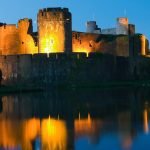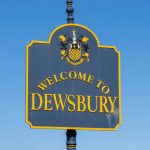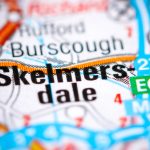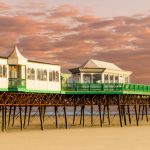A Five Minute Reading Guide To Reading
Reading, did you read them differently, or not? Now that you are in a state of suitable confusion, let’s bungle up your brain even more with one of our bamboozling city guides. Reading is on today’s menu, so strap in, buckle down, and let’s see what this fine town brings us…
A quick overview of Reading
This is one large town, located in the Thames Valley Berkshire and world-famous for its music festival. However, there is so much more to it and as you will see, it has more than its fair share of history. Reading sits at the meeting place of two major rivers the Thames and the Kennet,…One of the most populace stretches of water in Britain. It is about 40 miles west of London on the M4 so well within the capitals commuter belt, but much closer to Oxford, which is roughly 20 miles to the north.
Reading made fame throughout history as home to one of the richest monasteries in Europe. Around the 8th century, it was a noted market town of strong faith. Up until the Civil War, it was one of the biggest towns in England. It grew again in the industrial revolution but has shrunk since. One of the other things it has been most famous for throughout history is the brewing of beer. So it had the biggest monastery and the most beer.
We wanted to get deep down and dirty with the Reading town history. We’ll also cover famous faces, tourist attractions, and where to go for a night out on the town in Reading.
Reading Long Ago
Speculation is that people have occupied the area here since the Roman occupation, which was around 80AD. Some sources have it as a town as early as the 6th century. Certainly, the position between the two rivers made it ideal for trading. Local Histories point out there was a recorded Saxon leader named Reada Ingas who settled in the area in the 6th century. This seems like a good enough coincidence for us.
In the 9th century, the town’s name had become Readingum. We know this because of records of a Danish attack ain 871. The Vikings were invading Wessex and used Reading as a camp to attack from. They made a fort to the east of town before winter forced them back. Reading doesn’t pop up again until 1006 when the next lot of Vikings burned it down. Silly, since they built some of it. Luckily they didn’t burn it all because it is mentioned in the Domesday Survey of 1086.
By the time of Domesday, the town was a borough with 6 working mills. After 1066 and the Norman Conquest, some of the land around Reading was passed on to the Benedictine Abbey in East Sussex. They owned the land until Henry the I was buried in 1121 at Reading Abbey. As part of his death, he left his Reading lands to the Abbey. That East Sussex Abbey was known as Battle Abbey. Although Reading got the land back, Battle Hospital remains to this day as a testament to this period of history.
Wool was treated in Reading; it grew in reputation as a manufacturing town. Cloth was woven here. Since the town is on the road connecting London with Cornwall and Wales there was a steady supply of trade passing through. The town filled with goldsmiths, carpenters, joiners, bakers and butchers. There were smiths and watermills, even a few slaves.
During the 11th-13th centuries, the town worked under the leadership of the Abbot. After Henry VIII declared war on all religions except his own the town passed to the hands of the merchants… but that wasn’t until the 16th century. By then, the merchants had elected a mayor of their own and were largely ignoring the abbot, anyway. Henry VIII tried and hanged the last abbot. He was drawn and quartered in front of his own church. Gruesome.
Up until this point, there were three churches, the Abbey, a hospital run by the monks and a leper colony. The King had to make an example of at least one of them. St Mary’s still stands to this day but most of the rest were destroyed.
The Gap in Reading History
This is normally the part where we tell you that the 1348-9 plague killed 75% of the population – but there is a bit of a gap in Reading history at this point. There are not a lot of records from the time. The most likely reason for this is that anyone left alive was unable to write. We do know that they lost the abbot in 1361, so there must have been a later outbreak.
We took this break anyway because of a handful of articles we found regarding Cholera in Reading. People in the Thames Valley have been coming down with a spate of Victorian illnesses since 2017. You can read more about it here, but the diseases include Cholera, Gout, and Rickets. Words cannot express how sad it is that we seem to be going backwards.
Fun Facts About Reading!
We thought we ought to lighten the mood a little after that. Here at Five Minutes Spare, we like to keep things fun. With that goal in mind, here are some interesting facts about Reading, to keep things light…
Reading fun facts:
- It is home to a mural celebrating black history The mural which is around 36 meters long was completed in 1990 by artist Alan Howard.
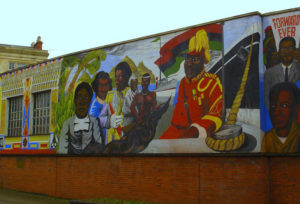
Image by Julian Walker CC BY-NC-ND 2.0
- In the 1660’s plague outbreak, the council in Reading set up separate houses where plague victims could stay away from everyone else. It worked. As far as we know, Reading residents fought off that particular wave.
- It is the biggest town in the UK that doesn’t have city status. Reading has more than 230,000 residents in its immediate vicinity, and 337,000 residents in its entire urban area. There are cities in other parts of the UK that are less than half the size of it!
- When it was built in 1977, Lower Earley was the biggest council house estate in Europe.
- Edith Morley became the first-ever female professor in Britain in 1908, at the University of Reading.
- Gun Street, in reading town, is named so because of all the gunsmiths that used to work here.
There now, don’t you feel refreshed? Let’s discuss Reading town from the 17th century onwards.
17th Century and Onwards in Reading Town
This huge town prospered greatly from their treatment and weaving of wool and cloth. The six mills in 1086 grew and expanded. Around 1610 the population was approaching 5k, with cloth being just about the only occupation. In 1628 on of the first workhouses in Britain was built, perhaps not something to be proud of. The Oracle was excavated in 1998 before the new retail centre of the same name was built.
For a while, the town was the biggest in Berkshire… now it is the biggest town in England. When the textile industry dissolved, they made pins, then nails, then wire. Later came tobacco pipes, guns and silk. When the civil war struck in 1642 the town started a more serious demise than just industry.
The king marched into town and fortified it. The following April saw the town laid siege to by Cromwell’s buddies. The siege was not successful because of the confluence of rivers. It didn’t matter since the royal army eventually decided it was too exposed to hold. However, the opposition-held onto Reading until September of that year. The royalists came back, the opposition cleared out. The opposition came back, the royalists cleared out. After that nobody wanted what was left.
In 1688 King James II fled abroad but left his troops in Reading. The townsfolk sent to the Dutch for help because they were terrified of these Irish inhabitants. There was a massacre of Irishmen that day.
The Industrial Revolution
At the turn of the 18th century, Reading is described as being 900 houses full and famous for clothing. A Newspaper called the Reading Mercury started in 1723, marking a smooth distinction between the old market town and the new ‘thinking’ town. Both a boy’s school and a girl’s school opened within two hundred years of each other – which isn’t bad. Oil and gas lamps arrived before 1820 – around about the same time as an additional canal was built.
The Great Western Railway passed through Reading and added it to the route in 1841, opening the town up to the whole world. Cloth died as a trade, especially the old leather and wool garments the town was famed for. However, just before the 19th century, the first proper brewery opened in town and it started a chain reaction. This new interest in alcohol attracted everyone, making the town a haven for craftsmen. The population doubled in that hundred years.
By 1801 industry was in full thrive. They really did to everything here. The Royal Berkshire Hospital arrived in 1843, sewers went in around 1850, and municipal buildings were added in 1862. Three more schools opened – one dedicated to science. In 1889 the town grew even larger and trams were introduced. The University opened in 1926.
Although there is no record of the town being bombed by Zeppelins in WW1, the town’s bodily contribution to the war effort cannot be denied. One of WWI’s medical hospitals was the Royal. BBC Radio Berkshire has some nice audio tales of Reading during both wars for those that are interested.
The Second World War saw Reading marked as a safe town that wouldn’t be bombed. One lone Luftwaffe pilot proved everyone wrong. He flew down the main street, machine-gunning civilians. 41 people were killed and 100 were injured. You sometimes wonder what sort of person can do things like that.
Since the second world war the town as gone from strength to recession and back to strength again. At the moment, the main industry and commerce comes from retail, although there are plenty of other jobs available.
Anyway – Let’s end our brief historical tour on a high by proving how much this one town has contributed to the world.
Famous People from Reading, in Berkshire
There are more than a few famous faces to come out of the Thames Valley. Some of the Five Minutes Spare favourites are as follows:
- Jane Austen who would go on to write numerous classics commencing with Sense & Sensibility (1811) was educated at the then acclaimed Reading Abbey Girls’ School.
- Charlie Brooker, writer of “Black Mirror” is from Reading – and so is Ricky Gervais, famous actor and animal activist.
- Kate Middleton, Duchess of Cambridge, and our second favourite Royal (after The Queen of course) was born here at the aptly named Royal Berkshire Hospital.
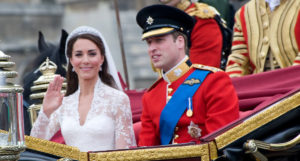
The Duchess of Cambridge Kate Middleton was born here. Image: Featureflash Photo Agency/Shutterstock.com
- William Henry Fox Talbot was born here. We know it means nothing to most in this digital age, however, he was an early pioneer in the field of photography. He is responsible for some of the earliest photographs of Reading.
You can find a full list of famous folk out of Reading by following this link.
Attractions in Reading
So if you have come to a guide to the town of Reading, it’s probably because you are either staying there, or you are from there. If you are there on holiday, we can help you have the most fun. Pack you’re itinerary with some Five Minutes Spare favourites and never miss a moment of holiday fun.
Britain has a proud tradition of horse racing and nowhere more so than in the town of Reading. Through various royal visits over the years, Reading has been important to kings and queens since back in the days of Henry I. In 1711, Queen Anne designated space in East Cote for their horses to reach full gallop. In 1744 the familiar green-coated security guards were added to protect royalty while they watched the races.
The Royal Ascot circuit is one of the original racing circuits in the UK. Definitely visit if you can afford it or need an excuse to buy a new hat!
Historical Landmarks and Sights
Reading Abbey is still around although it does lie in ruins. It is in the centre of the county and has a fair amount of history attached. It’s actually really surprising how long stone structures can last. This place has stood since 1121.
The Mapledurham Estate makes for a second gorgeous old building for your perusal. This 12th-century family home has a preserved watermill and a sprawling estate for you to enjoy. They often host weddings and, once you see it, you will know why. Definitely worth a look.
Highclere Castle is in Reading. Don’t think you have heard of it? This is the building they use to shoot ‘Downton Abbey’ in! It’s well worth a tour, has its own gift shop and has acres of grounds you can enjoy. The castle also has mini exhibits that tell you all about the real history of living there throughout the ages.
One of the biggest crowd-pleasers in and around Reading is the adventure you will find at Legoland. Every year they add and change parts of their exhibits – but it whatever the theme is, you can bet it is built out of Lego. As well as Lego deep sea there is a Lego driving experience which is child-friendly, and there are a variety of rides to choose from, too.
Legoland is one of the best things to do in Reading with children. To be fair though, we think we would visit even if we didn’t have kids with us.
We mentioned that the new Oracle retail district takes its name from the old Oracle workhouse. What we didn’t tell you is that the current Oracle has more than 80 stores and seemingly limitless food courts in it. There is a Vue cinema which can keep everyone entertained in an evening, and the place also has its own bars. You could come on vacation to Reading and just stay here for the week.
Parks and Nature
Basildon Park is lovely because the old house is in the background. The whole estate is open to the public and features new exhibits every year. It is run by Historic England so do donate if you can. If you would prefer some nature, wildlife, and good times, try Beale Park on the river. You can have your choice of other parks in the area, too.
We suggest taking a trip out to Silchester and having a wander around. The church is open for visiting, and the area includes remnants of a Roman amphitheatre. There are city walls out here… but which city? You will have to visit to find out.
Galleries and Museums
The Museum of English Rural Life is in the town and is far more exciting than it sounds. It is actually part of Reading University and whats even better admission is pretty much free although some events do carry a small charge. It really is (in our opinion anyway) one of the best things to do in Reading and you can spend many hours here viewing the numerous galleries reflecting different aspects of country life and one of their more interesting stories is about how families from the country would come to the banks of the Thames on holiday. In order to pay for this luxury, they would pick hops for pay while they were here! But for the nostalgist, the pinnacle will be the Ladybird Gallery, and no it’s not full of colourful spotted Beatles but instead is dedicated to the much-loved ladybird book series which was a stalwart of many a childhood. It also has a shop and cafe plus a really nice garden with well-tended lawns, a wildflower bank and woodland areas; really a little oasis. There are even some fruit trees, although we wouldn’t recommend picking the fruit.
If art galleries are more thor thing then you are somewhat spoiled for choice with the Castle Galleries being a great choice for contemporary art while the Lemon Grove Gallery. Either will give great art and leave you fully inspired. If you want to catch a show at a really impressive venue, then you may want to check out the Hexagon and see what’s on.
Reading F.C. are out there, doing their thing. You can visit the stadium and take a tour or visit to catch a game. You will hear them on the weekends if you are from out-of-town.
Other Notable Attractions in and around Reading
There is a tonne of things to do in Reading that we couldn’t quite cover – but are still worth a mention. Some other things to do include:
- Visit Thorpe Park which is within a half-hour drive. This theme park is great for little ones but does get a bit spooky around Halloween time.
- Visit the University of Reading, if you are feeling really bold sneak in there, and listen to a lecture. Nobody will notice.
- Visit Reading Museum to learn all about the town itself and its history. They change their exhibitions fairly regularly so there is always something new to see.
- Reading Station is a landmark in itself. It has been in operation since away back when the Great Western Railway was first laid. Definitely worth a visit.
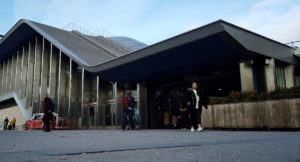
The Station may be old but it has a slightly modern architectural look. Image: photocritical/Shutterstock.com
- The Forbury Gardens make a lovely place to go for a walk or see some floral arrangements. It even has a rather imposing sculpture of a Lion!
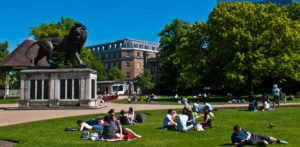
Forbury Gardens is a must-visit if the sun is shining. Image: Luis Santos/Shutterstock.com
So as you can see there is absolutely no excuse for anyone to be bored while visiting Reading!
Where to Eat, Drink and Party in Reading?
If you are looking for a family meal then try Quattro for some nice Italian. It’s affordable, good food. Revolution is nice dining for a date, while Cilantro is the place to be if you are attending a business meeting.
In terms of cocktails, reviewers like Milk, the Cerise Bar and Be at One on Gun Street. Be at One are known throughout the cities of southern England for their ability to provide nightlife you always remember. If you fancy stumbling home a little later though, add in a trip to the Purple Turtle… what a name.
If you just want old-school ale, try Greyfriars. Otherwise, you are all set for a night on the tiles… enjoy!
How to Get there?
We seem to have rounded up just about everything. All that is left to tell you is how you get to Reading (in Berkshire, not Massachusetts).
By Road
If you head west out of London towards Slough on the M4 you are travelling in the right direction. Keep going.
By Rail
You have your choice of stations. Reading Station is the most central. Head for it and worry about the smaller stations once you are in town.
By Boat
Follow the Thames out of London and you will get to Reading and with a nighttime view like this its worth considering!
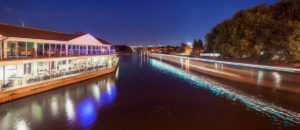
The River Thames at Reading looks quite spectacular, especially at night. Image: Sterling Images/Shutterstock.com
By Air
Heathrow in London is your closest airport. From there, you are a short journey by train to Reading Station.
Got Five Minutes?
If you enjoyed our guide to Reading but still crave more wholesome attraction goodness: head on over to the Five Minutes Spare travel section. You will find loads of similar guides to this one, all set to entertain you for hours. We don’t know whether to apologise or not… Have fun!

